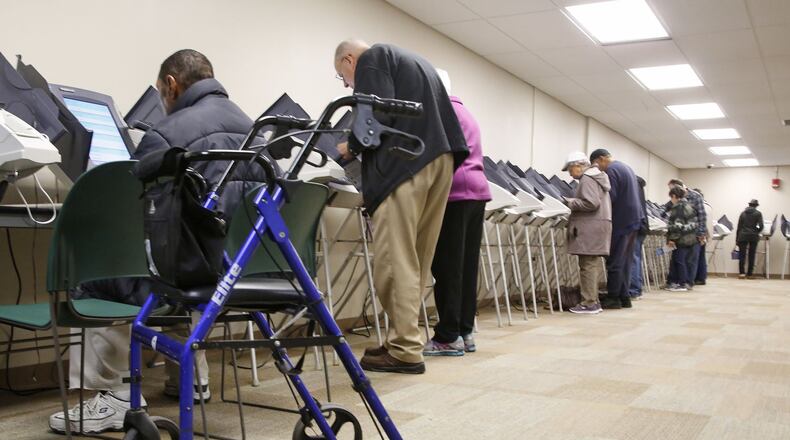Legislative leaders in the House and Senate signaled they want the process changed after voters rejected the latest attempt at a statewide issue — State Issue 1. They indicated they don’t like outside groups trying to change the state constitution to suit special interests.
Issue 1 was widely opposed by members of the Ohio legislature and judiciary. It would have placed new rules into the Ohio Constitution that would have reduced criminal sentences for some drug crimes, among other changes. The campaign to get it on the ballot was funded largely by out-of-state supporters of drug-decriminalization reform including Facebook founder Mark Zuckerberg and his wife Priscilla Chan, Nicholas and SusanPritzker of San Francisco and George Soros’ Open Society Policy Center.
“I think the Ohio Constitution has been used and abused for decades,” said Senate President Larry Obhof, R-Medina. “ I know a great number of my colleagues feel the same way: we think that document is sacrosant. ”
Obhof hasn’t offered any details yet but has said any changes to ballot access requirements would require voter approval.
“Frankly, I’m growing very weary of having to defend against bad ideas that don’t belong in the constitution because there is a cottage industry in Columbus of people who earn a living …by selling or trying to sell parts of the Ohio Constitution,” he said.
Over the past century, Ohio voters have approved one-in-four citizen-driven constitutional amendments. Ohioans have rejected 52 such measures and approved 17 between 1913 and 2015, according to a summary from the Ohio Secretary of State.
In recent decades, some of the most significant public policy changes arrived in Ohio via ballot issues pushed by citizen groups. Issues have involved efforts to tie minimum wage increases to inflation, outlaw same-sex marriage, ban smoking at indoor workplaces and legalize casino gambling in the state.
The threat of a ballot issue has indirectly pressured lawmakers to take action on thorny topics such as medical marijuana and reform of how the state’s legislative districts are drawn.
“I hope Ohioans are paying attention. It’s their right to direct democracy that is threatened by this effort,” said Tracy Sabetta, a driving force behind a 2006 state issue that sought to ban smoking indoors. Voters approved the measure. Public health advocates pushing for a smoking ban had been unsuccessful in getting such a ban through the state legislature. So it was the voters that approved one of the biggest public health advancements in Ohio history.
Sabetta said it wasn’t easy.
“It is very difficult to get an issue on the ballot in Ohio without raising a significant amount of money and having strong public support from the very beginning,” she said. The smoking ban was the first citizen-initiated statute to pass in Ohio in 50 years.
Even after it passed, public health advocates had to beat back attempts by some lawmakers to immediately weaken the new law, Sabetta said. The risk that legislators will simply change a voter-approved law gives groups incentive to seek the changes as constitutional amendments, which cannot be changed without another constitutional amendment, she said.
Sabetta said lawmakers should make it easier for citizen-initiated statutes to get on the statewide ballot and trust voters to get it right.
“Ohioans are pretty savvy when it comes to ballot issues. They know how to do their homework,” she said.
Jen Miller, director of the League of Women Voters of Ohio, said the citizen-initiated statute process should be made easier - not harder. She said it should include protections against legislators changing voter-approved laws. “The General Assembly should make direct democracy easier,” she said. “It takes a lot of time, it takes a lot of money and it should not be taken away.”
Three paths to the Ohio Ballot
— The Ohio General Assembly can vote to put a constitutional amendment before voters. Between 1913 and 2015, voters have approved 104 of 152 such proposals.
— Citizens can collect 306,000 valid voter signatures from 44 of 88 counties to place a constitutional amendment on the statewide ballot. Between 1913 and 2015, voters approved 17 of 69 such proposals. Also, the signature threshold is based on the number of ballots cast in the last gubernatorial election — so it’ll jump to about 432,000 once the 2018 election results are certified.
— Or, citizens can collect 92,000 signatures from at least 44 counties for a citizen-initiated statute. Lawmakers then have four months to decide whether to adopt the proposed law, adopt an amended version or ignore it. If it is changed or ignored, citizens then have the option to collect another 92,000 new signatures to put the issue on the statewide ballot. (The threshold is expected to jump to 130,000 signatures soon.)
About the Author

